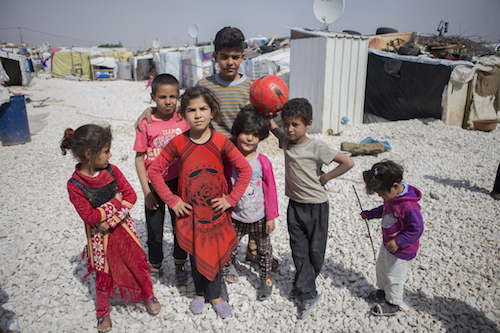Photo: Tabitha Ross
We really do spend on what we value. Or okay, we don't but we should. Leaders say they care about education globally, but a quick check on financial investments reveals how true that really is -- or isn't. Funding for education is low and has been declining since 2010, is poorly targeted at those countries and children most at risk and is worst in emergencies and crises where it could matter the most in protecting children in the short and long-term.
What do donors actually give to education?
The answer to that question is usually so disappointing that my colleagues who track down details on global education resource flow know what my first response to any aspect of those numbers will usually be: 'Good God (or some NSFW words) it's worse than I thought. And I thought it was pretty bad.'
Nowhere is this truer than when it comes to providing the protection of safe place to learn and play in conflict, disaster and protracted crisis. The research for a recent A World at School Education in Emergencies 'scorecard' honestly made me sick. The quick and awful:
- 75 million children and adolescents have had their education directly affected by emergencies and prolonged crises and 37 million have been forced out of school.
- Funding for education in emergencies has almost halved (41%) since 2010. In 2015 less than 2% of all humanitarian aid went to education.
- Only 12% of children in emergency situations in need of education assistance are being reached.
- Record numbers of emergencies has meant that the need for funding for education in emergencies has increased by 21% in the last 5 years.
- Six of the top ten donors to education have cut their support by more than 50% in the last five years.
The average length of displacement for a refugee is now 17 years. That's a lifetime lost or gained in terms of a child's education. But until now, despite the tireless work of those individuals and agencies in INEE (the International Network for Education in Emergencies), financing for this work can be described as laissez faire at best. An afterthought. A drop in the bucket.
We now have an annual $8.5 billion funding gap in funding for education in emergencies and protracted crisis every year.
Nowhere to go but up then? The scale of this resource problem is how we landed on the idea to create a Fund for education in these contexts. On 23 May at the World Humanitarian Summit the 'Education Cannot Wait Fund' will be launched and it will be...
Imperfect.
But it will be a start. The launch of this Fund is the single most important collective move to change the nature of humanitarian response to include education and has the potential to shift the conversation from one of scarcity to one where some of the most at risk children and their families and communities can actually imagine a future.
After that start there will be a steady process of change and growth. The coming years will see a refining of the Fund's mandate -- expanding or narrowing the work based on new opportunities, better data and the increased attention that this process and the concurrent work of the Education Commission has and will continue to create.
There may be shifts in hosting arrangements and governance, rebranding and reform processes that are all part of building something strong, resilient and fit for purpose. There will be new partnerships, new solutions and increased transparency of financing, which may reveal we have farther to go than we even realized. There will be new innovations to enable the private sector to make greater contributions and new ways of better including civil society and affected communities.
The launch is the beginning of the hard work of many years. And for good reason, because there will also be new crises, and a rising demand for long-term learning and accreditation for those who are displaced or who have lost everything.
Where will the money come from?
The resources must be new. This is the number one thing we must insist in this moment. Contributions should not be pulled from current or future expected bilateral or multilateral funds for education, or existing disaster, health or humanitarian relief funding.
We must engage new and ambitious donors and reject the narrative of scarcity from existing donors that pretends there are no new resources that can be made available for protecting children and youth and rebuilding their futures. Turkey alone has spent at least $10 billion alone to cope with the influx of refuges from the war in Syria. A similar amount was raised recently in London for the overall response to Syria, with a private sector commitment of $75 million and for the first time a strong focus on education as part of the response.
How should the Fund work?
The Fund must not fragment current financing architecture, but strengthen and support existing structures. We've learned from the Global Fund and other financing mechanisms that we must strengthen relationships of all stakeholders and continually learn from the expertise of implementers who face daily operational challenges. What the Global Fund and GAVI, The Vaccine Alliance have also taught us is that mobilizing significant resources for previously neglected issues and people is possible. The Global Fund, which was launched in 2002 has raised more than $33 billion to fight AIDS, tuberculosis and malaria over the last 13 years and created a revolution in global health.
We've also learned that a key ingredient for mobilizing resources on such a large scale is to include elected civil society representatives from diverse backgrounds as part of Fund governance who have a clear mandate to consult with and keep broader education civil society informed. These actors do the hard work of maintaining the political momentum through each stage or building the Fund especially when the spotlight shifts away. Civil society also plays a critical role in maintaining accountability and in collectively asking the difficult questions of more politically powerful actors.
The process of creating Education Cannot Wait has increased attention to education in emergencies and protracted crisis from a range of academics, implementers, rights advocates, humanitarians, policy-makers, campaigners, private sector leaders and others. All have agreed that the need is urgent and immense. This combined outrage got us to this political moment when creating something new and ambitious was possible. If stoked, this outrage added to optimism and technical expertise can continue to fuel the revolution in education for all.
Quality education opportunities protect children and youth, help mitigate suffering, create hope, facilitate rebuilding and prevent future conflict. I'm excited for both the launch of Education Cannot Wait Fund and the harder process of figuring what is the absolute best we are capable of delivering for children, families and communities made vulnerable by crises.
With the creation of the Fund, there should finally be greater resources to do this work.
---
Dozens of NGOs have joined the Call to Action for ambitious new resources for education in emergencies at the World Humanitarian Summit. Leave a comment below to be added to the list for regular updates on progress and information about how to better engage.
Headline Photo: Syrian refugee Khalil Al Alzi, 13, with his brothers and sisters in Lebanon. Credit: Tabitha Ross

